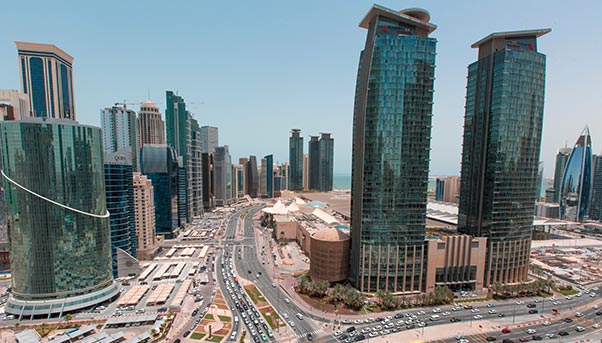
Doha’s Corniche at sunset is full of Westerners jogging with a few Arab families, their women wearing the hijab, taking a stroll with the skyline behind them. This long, half-moon-shaped artificial beach was designed to recreate the atmosphere of the French Riviera promenade, and it has become the liveliest area of the city. It is lined with luxury hotels like the historic pyramid-shaped Sheraton, and dominated by the marble cube of the Museum of Islamic Art, designed by star Chinese architect I. M. Pei. Behind the Corniche is a maze of streets in the souk, where people flock to the restaurants and night clubs that remain open until the wee hours. During Russia’s World Cup, Qataris – who are the Gulf’s biggest football fans — packed the souk’s shisha bars. This is more than just football mania. In four years, it will be Doha’s turn to host the World Cup and, for Qatar, it will be more than just the biggest international event in its history. It will be a once in a lifetime opportunity to improve its status in the world.
For these reasons, its infrastructure plan is nothing less than gigantic. According to the Middle East Economic Digest (MEED), Qatar will spend $100 billion on infrastructure linked to the world’s most popular football tournament. It is an important challenge and Qatar wants to be ready to meet it. When it was picked in 2010 to host the World Cup, it was an historic event: the first time for an Arab nation, and the first time for such a small country, to host it. From the very start, the government laid out such a massive investment programme that in February 2017 Finance Minister Ali Shareef Al Emadi said Qatar was investing $500 million in infrastructure each week.
The bulk of the investments are concentrated on construction of the stadia, of which Qatar has practically none: spending is around $10 billion, according to a Qatar government agency SCDL. With a four-year countdown to the event, it is still not clear how many stadia are needed: Qatar has designed and started to build eight of them (see WBV https://www.webuildvalue.com/en/infrastructures/stadiums-as-works-of-art.html). But since then the FIFA has changed its mind. So the number of stadia could rise to 12 if the next World Cup is played by 48 countries instead of the current 32. The final decision has not yet been made, even if at the moment the construction underway has already reached a price tag of $50 billion. All the projects are being funded by mixed public–private partnerships (PPP).
The stadia, of course, call for a cascade of infrastructure spending, especially for transportation, to enable fans to move around to matches played by their countries: highways, parking lots, fly-overs, bridges and all of the other public works works needed to host millions of visitors.

West Bay, Qatar
“Soft” infrastructure
The stadia and the Doha subway system (https://www.webuildvalue.com/en/stories-behind-projects/revolutionising-the-way-doha-moves.html) are the most cyclopean infrastructure works Qatar is undertaking ahead of the World Cup in terms of size and visual impact. But another part of the investment is going to so-called “soft Infrastructure”, which are smaller but still necessary. At the top of this list is an overhaul of the sewage system. To achieve this, the public agency Ashgal has approved a vast plan called IDRIS, to build new sewers to drain all the waste water produced by the southern part of Doha. The project calls for the construction of a main pipeline below the city 40 kilometres long, along with 70 kilometres of run-offs and catchments for a total cost of $2.7 billion.
The other main “soft infrastructure” effort is for road transport: the Expressway Programme is the equivalent of IDRIS for streets. Ashgal is planning to build 240 intersections and off ramps, ranging from simple and every day stop lights to tunnels and flyovers. The country’s most important road project is the New Orbital Highway, a ring road that will surround Doha on three sides (the fourth side faces the sea) and will include a lane dedicated solely to truck traffic.The investment in this case will reach $4.6 billion. Other traffic arteries in the works are the Lusail Expressway, which will link Doha with Lusail, a satellite community (for a cost of $959 million); and the East-West Corridor, a ring road that is budgeted at $458 million.
An investment for the future
Qatar’s population has tripled from 700,000 to 2.2 million people over the past 10 years: the growing demand for housing has led to the construction of entire new towns (or actually more like suburbs or satellite cities than actual urban centers). To meet these new housing demands, new real estate developments are in the pipeline. The most important are Lusail City, Msheireb, Downtown Doha, Airport City and Energy City. No official numbers on single projects have been released, but according to a study by the Oxford Business Group, the state has set aside $20 billion for tourism and housing in these sparkling new suburbs.
These real estate developments are part of a broader explosion in the construction industry. According to Qatar’s Development Ministry, the building sector has posted continuous year-on-year growth since 2010. The same Oxford Business Group study calculates that the Qatar National Vision 2030 programme – a mega state development plan that has mapped out the country’s economic strategy for the coming years – calls for public spending of some $200 billion (including the $100 billion earmarked for the World Cup). This avalanche of money will bring investment spending in Qatar to reach 30% of gross domestic product. A level unseen in any other country in the world, and one that goes a long way to demonstrating Qatar’s ambition to create a prestigious role for itself in the Gulf and the entire region.

